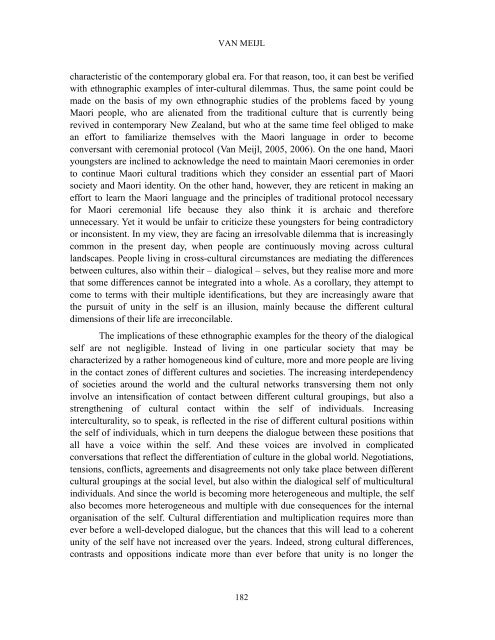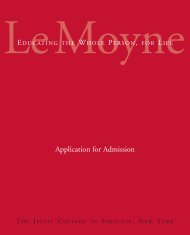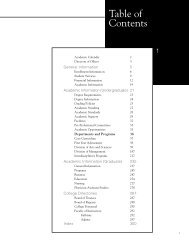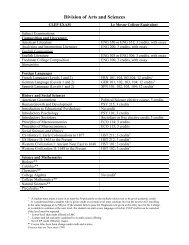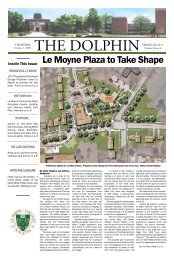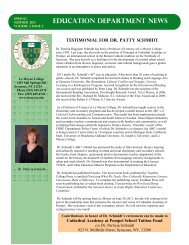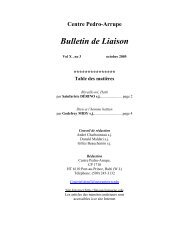165 culture and identity in anthropology: reflections on 'unity'
165 culture and identity in anthropology: reflections on 'unity'
165 culture and identity in anthropology: reflections on 'unity'
Create successful ePaper yourself
Turn your PDF publications into a flip-book with our unique Google optimized e-Paper software.
VAN MEIJLcharacteristic of the c<strong>on</strong>temporary global era. For that reas<strong>on</strong>, too, it can best be verifiedwith ethnographic examples of <str<strong>on</strong>g>in</str<strong>on</strong>g>ter-cultural dilemmas. Thus, the same po<str<strong>on</strong>g>in</str<strong>on</strong>g>t could bemade <strong>on</strong> the basis of my own ethnographic studies of the problems faced by youngMaori people, who are alienated from the traditi<strong>on</strong>al <str<strong>on</strong>g>culture</str<strong>on</strong>g> that is currently be<str<strong>on</strong>g>in</str<strong>on</strong>g>grevived <str<strong>on</strong>g>in</str<strong>on</strong>g> c<strong>on</strong>temporary New Zeal<str<strong>on</strong>g>and</str<strong>on</strong>g>, but who at the same time feel obliged to makean effort to familiarize themselves with the Maori language <str<strong>on</strong>g>in</str<strong>on</strong>g> order to becomec<strong>on</strong>versant with cerem<strong>on</strong>ial protocol (Van Meijl, 2005, 2006). On the <strong>on</strong>e h<str<strong>on</strong>g>and</str<strong>on</strong>g>, Maoriyoungsters are <str<strong>on</strong>g>in</str<strong>on</strong>g>cl<str<strong>on</strong>g>in</str<strong>on</strong>g>ed to acknowledge the need to ma<str<strong>on</strong>g>in</str<strong>on</strong>g>ta<str<strong>on</strong>g>in</str<strong>on</strong>g> Maori cerem<strong>on</strong>ies <str<strong>on</strong>g>in</str<strong>on</strong>g> orderto c<strong>on</strong>t<str<strong>on</strong>g>in</str<strong>on</strong>g>ue Maori cultural traditi<strong>on</strong>s which they c<strong>on</strong>sider an essential part of Maorisociety <str<strong>on</strong>g>and</str<strong>on</strong>g> Maori <str<strong>on</strong>g>identity</str<strong>on</strong>g>. On the other h<str<strong>on</strong>g>and</str<strong>on</strong>g>, however, they are reticent <str<strong>on</strong>g>in</str<strong>on</strong>g> mak<str<strong>on</strong>g>in</str<strong>on</strong>g>g aneffort to learn the Maori language <str<strong>on</strong>g>and</str<strong>on</strong>g> the pr<str<strong>on</strong>g>in</str<strong>on</strong>g>ciples of traditi<strong>on</strong>al protocol necessaryfor Maori cerem<strong>on</strong>ial life because they also th<str<strong>on</strong>g>in</str<strong>on</strong>g>k it is archaic <str<strong>on</strong>g>and</str<strong>on</strong>g> thereforeunnecessary. Yet it would be unfair to criticize these youngsters for be<str<strong>on</strong>g>in</str<strong>on</strong>g>g c<strong>on</strong>tradictoryor <str<strong>on</strong>g>in</str<strong>on</strong>g>c<strong>on</strong>sistent. In my view, they are fac<str<strong>on</strong>g>in</str<strong>on</strong>g>g an irresolvable dilemma that is <str<strong>on</strong>g>in</str<strong>on</strong>g>creas<str<strong>on</strong>g>in</str<strong>on</strong>g>glycomm<strong>on</strong> <str<strong>on</strong>g>in</str<strong>on</strong>g> the present day, when people are c<strong>on</strong>t<str<strong>on</strong>g>in</str<strong>on</strong>g>uously mov<str<strong>on</strong>g>in</str<strong>on</strong>g>g across culturall<str<strong>on</strong>g>and</str<strong>on</strong>g>scapes. People liv<str<strong>on</strong>g>in</str<strong>on</strong>g>g <str<strong>on</strong>g>in</str<strong>on</strong>g> cross-cultural circumstances are mediat<str<strong>on</strong>g>in</str<strong>on</strong>g>g the differencesbetween <str<strong>on</strong>g>culture</str<strong>on</strong>g>s, also with<str<strong>on</strong>g>in</str<strong>on</strong>g> their – dialogical – selves, but they realise more <str<strong>on</strong>g>and</str<strong>on</strong>g> morethat some differences cannot be <str<strong>on</strong>g>in</str<strong>on</strong>g>tegrated <str<strong>on</strong>g>in</str<strong>on</strong>g>to a whole. As a corollary, they attempt tocome to terms with their multiple identificati<strong>on</strong>s, but they are <str<strong>on</strong>g>in</str<strong>on</strong>g>creas<str<strong>on</strong>g>in</str<strong>on</strong>g>gly aware thatthe pursuit of unity <str<strong>on</strong>g>in</str<strong>on</strong>g> the self is an illusi<strong>on</strong>, ma<str<strong>on</strong>g>in</str<strong>on</strong>g>ly because the different culturaldimensi<strong>on</strong>s of their life are irrec<strong>on</strong>cilable.The implicati<strong>on</strong>s of these ethnographic examples for the theory of the dialogicalself are not negligible. Instead of liv<str<strong>on</strong>g>in</str<strong>on</strong>g>g <str<strong>on</strong>g>in</str<strong>on</strong>g> <strong>on</strong>e particular society that may becharacterized by a rather homogeneous k<str<strong>on</strong>g>in</str<strong>on</strong>g>d of <str<strong>on</strong>g>culture</str<strong>on</strong>g>, more <str<strong>on</strong>g>and</str<strong>on</strong>g> more people are liv<str<strong>on</strong>g>in</str<strong>on</strong>g>g<str<strong>on</strong>g>in</str<strong>on</strong>g> the c<strong>on</strong>tact z<strong>on</strong>es of different <str<strong>on</strong>g>culture</str<strong>on</strong>g>s <str<strong>on</strong>g>and</str<strong>on</strong>g> societies. The <str<strong>on</strong>g>in</str<strong>on</strong>g>creas<str<strong>on</strong>g>in</str<strong>on</strong>g>g <str<strong>on</strong>g>in</str<strong>on</strong>g>terdependencyof societies around the world <str<strong>on</strong>g>and</str<strong>on</strong>g> the cultural networks transvers<str<strong>on</strong>g>in</str<strong>on</strong>g>g them not <strong>on</strong>ly<str<strong>on</strong>g>in</str<strong>on</strong>g>volve an <str<strong>on</strong>g>in</str<strong>on</strong>g>tensificati<strong>on</strong> of c<strong>on</strong>tact between different cultural group<str<strong>on</strong>g>in</str<strong>on</strong>g>gs, but also astrengthen<str<strong>on</strong>g>in</str<strong>on</strong>g>g of cultural c<strong>on</strong>tact with<str<strong>on</strong>g>in</str<strong>on</strong>g> the self of <str<strong>on</strong>g>in</str<strong>on</strong>g>dividuals. Increas<str<strong>on</strong>g>in</str<strong>on</strong>g>g<str<strong>on</strong>g>in</str<strong>on</strong>g>terculturality, so to speak, is reflected <str<strong>on</strong>g>in</str<strong>on</strong>g> the rise of different cultural positi<strong>on</strong>s with<str<strong>on</strong>g>in</str<strong>on</strong>g>the self of <str<strong>on</strong>g>in</str<strong>on</strong>g>dividuals, which <str<strong>on</strong>g>in</str<strong>on</strong>g> turn deepens the dialogue between these positi<strong>on</strong>s thatall have a voice with<str<strong>on</strong>g>in</str<strong>on</strong>g> the self. And these voices are <str<strong>on</strong>g>in</str<strong>on</strong>g>volved <str<strong>on</strong>g>in</str<strong>on</strong>g> complicatedc<strong>on</strong>versati<strong>on</strong>s that reflect the differentiati<strong>on</strong> of <str<strong>on</strong>g>culture</str<strong>on</strong>g> <str<strong>on</strong>g>in</str<strong>on</strong>g> the global world. Negotiati<strong>on</strong>s,tensi<strong>on</strong>s, c<strong>on</strong>flicts, agreements <str<strong>on</strong>g>and</str<strong>on</strong>g> disagreements not <strong>on</strong>ly take place between differentcultural group<str<strong>on</strong>g>in</str<strong>on</strong>g>gs at the social level, but also with<str<strong>on</strong>g>in</str<strong>on</strong>g> the dialogical self of multicultural<str<strong>on</strong>g>in</str<strong>on</strong>g>dividuals. And s<str<strong>on</strong>g>in</str<strong>on</strong>g>ce the world is becom<str<strong>on</strong>g>in</str<strong>on</strong>g>g more heterogeneous <str<strong>on</strong>g>and</str<strong>on</strong>g> multiple, the selfalso becomes more heterogeneous <str<strong>on</strong>g>and</str<strong>on</strong>g> multiple with due c<strong>on</strong>sequences for the <str<strong>on</strong>g>in</str<strong>on</strong>g>ternalorganisati<strong>on</strong> of the self. Cultural differentiati<strong>on</strong> <str<strong>on</strong>g>and</str<strong>on</strong>g> multiplicati<strong>on</strong> requires more thanever before a well-developed dialogue, but the chances that this will lead to a coherentunity of the self have not <str<strong>on</strong>g>in</str<strong>on</strong>g>creased over the years. Indeed, str<strong>on</strong>g cultural differences,c<strong>on</strong>trasts <str<strong>on</strong>g>and</str<strong>on</strong>g> oppositi<strong>on</strong>s <str<strong>on</strong>g>in</str<strong>on</strong>g>dicate more than ever before that unity is no l<strong>on</strong>ger the182


